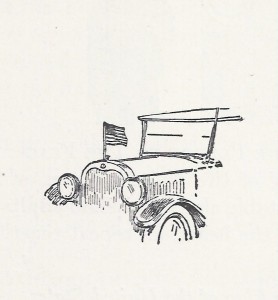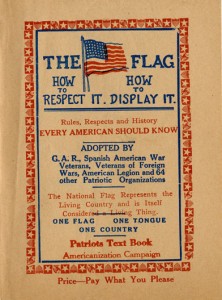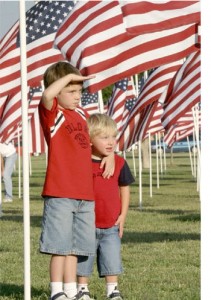Honoring the Flag
Rules of flag display were of little concern in the United States until after the Civil War, and then flags were usually draped and festooned to decorate buildings and halls for ceremonies and celebrations. As decorative displays using the Stars and Stripes increased during the nation’s centennial in 1876, some Americans began to question if some displays were in good taste. At the same time merchants used the flag in their advertisements in ways that many found distasteful. A keg of whiskey wrapped in the Stars and Stripes, a stores entrance shaded by an awning made of Old Glory—these were just two examples of commercial exploitation of the U.S. flag.
As the nineteenth century moved to its close, patriotic organizations called for laws to be enacted that would protect the U.S. flag and provide rules for proper display. While this resulted in some legislation to bar use of the flag in advertizing, rules of flag display remained rare. During World War I display of the flag surged and Americans looked for guidelines of flag display.
The few rules that began to appear were often contradictory and confusing. The Boy Scouts might display a flag one way while the Sons of the American Revolution might do something opposite.
In January of 1917, the Army’s Adjutant general issued a set of guidelines known as the Flag Circular. The Adjutant General began his circular by admitting that he had no jurisdiction of display for the flag by civilians. Nevertheless, he would suggest some guidelines for flag display which he hoped would prove helpful.
Then ninety years ago, in 1923 the American Legion sent out a call to patriotic associations to gather in Washington, D.C. to produce a Flag Code which would provide rules for appropriate flag display. The American Flag Code Convention met in June of that year to prepare a list of rules for flag display, and they compiled the first Flag Code comprising a list of rules for civilian flag display.
Although patriotic organizations repeatedly asked the federal government to adopt the Flag Code, Congress was slow to act. Finally almost twenty years later, in the midst of World War II, Congress in 1942 adopted the U.S. Flag Code which was based largely upon the work of the American Flag Code Convention.

The rule governing display of a flag on an automobile’s radiator cap was not deleted from the Flag Code until the 1976 revision.
In 1976 the Veterans of Foreign Wars spearheaded the revision and updating of the U.S. Flag Code, and it was then that a rule for clamping a flag to an automobile’s radiator cap was finally deleted. However, with changing ways of flag display, the Flag Code seems never to be fully up to date.
People often assume that the U.S. Flag Code covers every question of flag display. Unfortunately, it does not. Many also assume that rules found in the Flag Code describe the only way to correctly honor a flag. In fact the U.S. military, the Federal Government’s departments and foreign nations have some provisions that either are not found or are different from rules found in the U.S. Flag Code.
Further complicating the issue of flag display is that some individuals insist that their interpretations of rules found or rules which they believe are found in the Flag Code are the only way to correctly honor the U.S. Flag.
Business and organizations that display flags at their facilities report that no matter how they display the flag, they will receive calls from indignant individuals insisting that the flag is being displayed incorrectly. Complainers often further insist that the display dishonors the flag.
Colonial Flag Company has resources to help Americans who want to fly the flag correctly and will be happy to respond to questions about flag display. We refer not only to the U.S. Flag Code, but to other military and government regulation. We also check, as appropriate, rules of flag display followed in various states and in foreign countries. No, as surprising as it may be, they do not always agree.
Colonial Flag believes that the vast majority of those who display the U.S. flag desire to honor the flag and all the flag symbolizes, and that an error in flag display does not mean that the flag has been dishonored. As stated before, the Flag Code does not clearly answer all questions about flag display, and to some degree it is not up to date with the way Americans display the flag in the 21st Century. When we become too dogmatic and inflexible about flag display, we discourage people from displaying the flag, and that is unfortunate.
Someone can follow all the rules of flag display and still dishonor the flag. It is how we live our lives as citizen that determines if we truly honor the flag. As Paul Swenson, the owner of Colonial Flag Company has said, “The Flag is made up of millions of stitches just as the United States is made up of millions of citizens. We each need to take care of our own stitch to keep the flag an honored symbol.”



